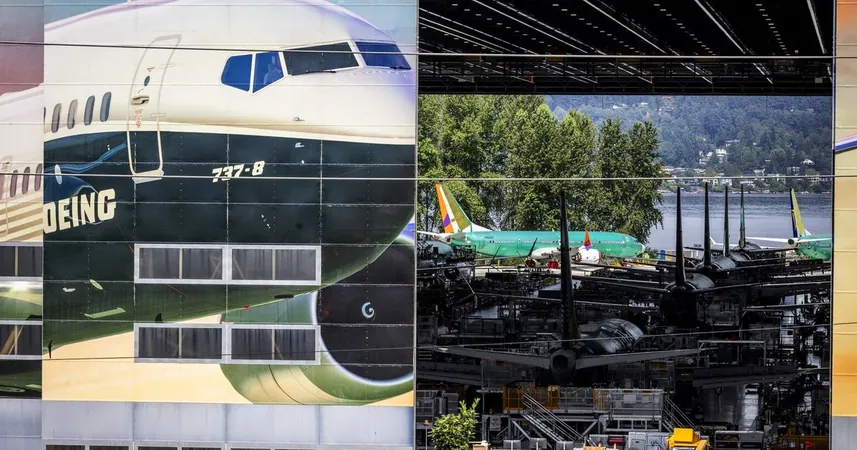
Boeing's Drastic Layoff Strategy: A Prelude to a Shocking Workforce Transformation?
2024-10-15
Author: Ting
In a bold move that signals troubling times ahead, Boeing has announced that its upcoming layoffs will be entirely involuntary, meaning employees won’t receive any financial incentives to leave voluntarily. This revelation follows a "Reduction In Force" (RIF) plan unveiled to managers of Boeing Commercial Airplanes, marking a significant shift in the company's staffing structure.
A Boeing spokesperson, Jessica Kowal, confirmed that the initial wave of layoffs will target white-collar staff, including engineers and salaried employees up to vice-presidential levels. Notably, members of the Machinists union, who are currently striking, are not expected to be part of these layoffs at this stage, suggesting that Boeing’s strategy may evolve further down the line.
Timeline of Turmoil
The layoff process is structured into two distinct phases. By the end of this month, managers are expected to finalize their lists of affected employees. The first wave of layoff notifications will occur between November 13 and November 15, with those affected receiving 60-day notices for an official layoff date set for January 17. A second phase of layoffs may take place on February 21, contingently depending on whether the company meets its goal of reducing its workforce by 10%, representing around 17,000 positions across the organization.
Despite the unsettling nature of these impending layoffs, affected employees will receive their regular pay until their termination date, providing a brief window — albeit overshadowed by the looming holiday season — to search for new opportunities. Additionally, severance packages will be offered to those who are ultimately let go.
Criteria for Cuts: Who's Next?
According to the internal presentation slides obtained by The Seattle Times, layoff criteria include performance reviews of employees at all levels, starting with a focus on "lower performers." Managers will also evaluate financial overhead costs, identify work that can be deprioritized, and consider which skills are essential for the company's future. Even contractors may face layoffs, excluding specialized positions whose employment contracts are already limited.
Interestingly, the current union strike has excluded Machinists from these layoffs. Experts believe that laying off blue-collar workers might exacerbate tensions and complicate resolution efforts. Nonetheless, the need for these layoffs appears rooted in a larger plan of reorganization initiated by newly appointed CEO Kelly Ortberg, amidst ongoing financial struggles for the aerospace giant.
Boeing’s Troubling Financial Landscape
Boeing's financial troubles have intensified since a serious incident involving Alaska Airlines earlier this year, which called into question the company's quality control and production capabilities. The firm has been under strain as jet production rates have plummeted, with the company desperately trying to assure the Federal Aviation Administration that it is regaining control over its manufacturing processes.
As the market demands ramped-up production to meet pre-crisis rates, Boeing had actively recruited machinists, anticipating the need for significant manpower once the strike is resolved. This future dependence on skilled labor creates an ironic twist, as white-collar layoffs may disproportionately impact the engineers and staff who are essential for the company’s recovery trajectory.
Conclusion: The Road Ahead for Boeing
As uncertainty looms over the heads of approximately 33,000 Machinists and countless other employees, the message from Boeing is clear: tough decisions are underway, and the impacts are poised to resonate throughout the industry. Unlike past job cuts, where voluntary packages eased the burden, this time the firm stands firm on a harsh reality — no voluntary layoffs will be offered. The employees planning their futures can only brace themselves for what’s next.
Will this shake-up allow Boeing to regain its competitive edge in the aerospace sector, or is it merely a band-aid for deeper systemic issues? Time will tell as the countdown to layoff notifications ticks ever closer.





 Brasil (PT)
Brasil (PT)
 Canada (EN)
Canada (EN)
 Chile (ES)
Chile (ES)
 España (ES)
España (ES)
 France (FR)
France (FR)
 Hong Kong (EN)
Hong Kong (EN)
 Italia (IT)
Italia (IT)
 日本 (JA)
日本 (JA)
 Magyarország (HU)
Magyarország (HU)
 Norge (NO)
Norge (NO)
 Polska (PL)
Polska (PL)
 Schweiz (DE)
Schweiz (DE)
 Singapore (EN)
Singapore (EN)
 Sverige (SV)
Sverige (SV)
 Suomi (FI)
Suomi (FI)
 Türkiye (TR)
Türkiye (TR)